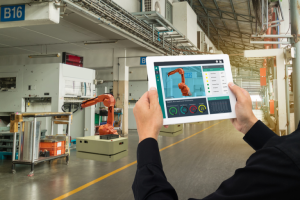
The first industrial robot was produced in 1956 and could move material 12 feet. Needless to say, the world of manufacturing robotics has developed greatly since then. While early robots were relegated to industrial manufacturing due to their safety hazards, modern distribution and manufacturing robots are smaller and can move easily around warehouses, moving, packaging, and sorting products.
The development of distribution and manufacturing robots has concerned many employees, who worry they will be replaced with robots. However, as with any other technological advancement, robots will take over certain jobs—but create new ones at the same time. When a machine performs a repetitive task in your warehouse, your employees can focus on higher-value work that a robot cannot duplicate.
Still, although robots can be of great help in the warehousing and distribution field, you need a system to connect robots with your business systems and employees: you need a powerful warehouse distribution software solution like Acumatica.
The 4 Benefits of Robots in Warehouses
Let’s begin with some benefits that robots can bring to your distribution business.
- Increased Capacity
Robots do not need sick days or breaks during the day. Therefore, the more automation you have in your warehouse, the greater its capacity for productivity. Although one may break down and need repairs, it may be possible to replace it with another robot temporarily.
- Mitigated Labor Shortage
The number of qualified warehouse workers is decreasing in America. As more people choose remote or knowledge work, robots can partially make up for staffing gaps and increase productivity without adding more stress or work for your current employees.
- Flexibility
Fulfillment demand ebbs and flows in somewhat unpredictable ways. In the distribution business, you must frequently adjust your warehouse’s operations to meet demand. Instead of changing your warehouse layout or using alternate shifts—both complicated and costly—you can easily adapt your robotics to fit the new situation.
- Real-Time Data-Driven Decisions
Through machine learning, robots can incorporate data into their functions. For example, based on your business data, a robot can assist your employees to combine multiple tasks in one trip across the floor, thus increasing productivity as well as protecting the employee from too much strain and exertion.
Working Together Through Warehouse Distribution Software
Managing a warehouse is hard enough—when you add robots into the mix, keeping everyone and everything on track is even more difficult. To maximize your investment in robotics, you need the right warehouse distribution software. The best solution is a modern, flexible, powerful ERP like Acumatica.
Acumatica gathers business data from across your company into a central repository, where it can be used by employees and robots alike. Acumatica’s warehouse distribution software gives you complete visibility into your warehouse’s operations and efficiency, allowing you to adjust as needed. After all, it doesn’t matter how much you automate your warehouse—if you aren’t making data-driven business decisions, your productivity, efficiency, and profitability will suffer.
Just like you can automate physical tasks with robots, you can automate data entry, documentation, and more through Acumatica. This automation empowers your employees to work on high-impact tasks—such as customer service or customer relationship management—that require creative problem-solving, emotional and social intelligence, and imagination.
Ready to Get Started?
For more information on how Acumatica can benefit all aspects of your business, read our free whitepaper here. If you’re ready to implement this powerful warehouse distribution software, the experts at EmeraldTC are ready to help. We can help you implement, customize, and integrate the perfect solution for your company. Contact us today to get started.

